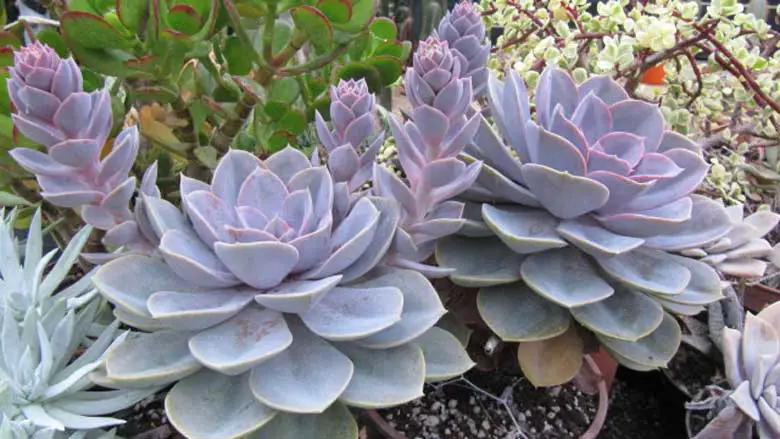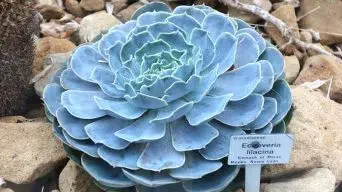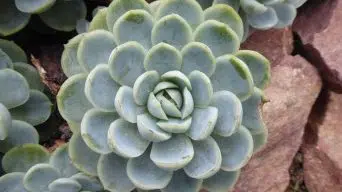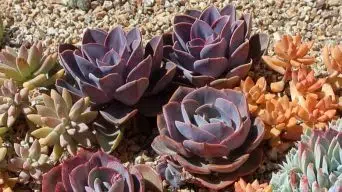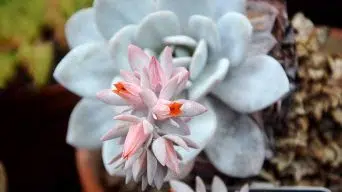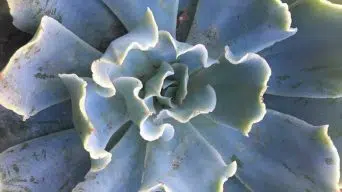Echeveria ‘Perle von Nurnberg’ is one of the most beautiful Echeveria species.
With its attractive rosette shape and gorgeous colors, this plant has all that it takes to be a show-stopper in your garden.
But what’s more interesting about this particular variety is how easy it is for you to take care of it.
So before you give up on this beautiful plant because you think caring for an Echeveria is too much trouble, read on!
This complete guide will teach you everything there is to know about taking care of the Echeveria ‘Perle von Nurnberg’.
Overview
Echeveria Perle von Nurnberg is an evergreen succulent from the Crassulaceae family, originating in succulents native to Mexico.
Richard Graessner created the hybrid Echeveria Perle von Nurnberg in Germany during the 1930s by crossing Echeveria gibbiflora with Echeveria elegans succulent plants.
Its rosettes are filled with pointed, thickened leaves that are grayish lavender highlighted in blush pink.
This Echeveria succulent can grow up to 8-10 inches tall (20-25 cm) and 6-8 inches wide (15-20 cm).
This succulent produces reddish stems with spikes of pink coral bell-like flowers on one (30.5 cm.) inch-long stalk.
How To Care for Echeveria ‘Perle von Nurnberg’

Echeveria ‘Perle von Nurnberg’ is an excellent choice for succulent beginners due to being easy to care for.
It’s also recommended for anyone wanting something colorful without too much maintenance involved.
Below you’ll find the most important information you need to know about caring for Echeveria ‘Perle von Nurnberg’.
Sun Exposure & Light Requirements
Echeveria ‘Perle von Nurnberg’ succulent plants thrive in full sun to partial shade and need approximately six hours of bright light per day.
If growing your Echeveria ‘Perle von Nurnberg’ inside where there is either no natural light or low levels of sunlight, place it next to a west-facing or east-facing window that gets plenty of bright, indirect sunlight.
Avoid placing it near a south-facing window, as this can cause the plant to become spindly and leggy from exposure to constant sun heat.
If your Echeveria ‘Perle von Nurnberg’ succulent becomes pale green, it is not receiving enough sunlight.
When growing your Echeveria ‘Perle von Nurnberg’ plant outdoors, avoid intense direct sunlight during the hottest parts of the day and provide partial shade to ensure that your plant remains healthy and does not burn.
Watering Requirements
Water your Echeveria ‘Perle von Nurnberg’ once weekly and allow the soil to dry out before deeply watering.
They should be watered more frequently during the summer months and less so in winter, only enough to prevent wrinkled leaves.
Echeveria ‘Perle von Nurnberg’ has a low water requirement; once a week should be enough.
It’s better to underwater than overwater these succulent plants; they’re not as tolerant to overwatering.
It’s appropriate to water it deeply, moisten the soil to a certain depth, and prevent water from collecting in between or around its leaves, just water enough to soak the soil slightly.
They should be watered thoroughly until water runs out of the bottom of the pot. Make sure you empty any excess water that may be inside the pot.
It’s easy to accidentally overwater succulent plants, as they’re pretty sensitive and drown easily if you water them too frequently. This is why you must wait for the soil to dry out a little bit before adding more water.
Small pots, around 3 inches in diameter, require much less water than larger ones.
Soil Requirements
You can make your own cactus soil by combining one-third of regular potting soil, two-thirds coarse sand, and one-third perlite.
Echeveria ‘Perle von Nurnberg’ succulents need well-draining soil like cactus soil or succulent soil mix.
These soils are specifically blended to ensure that they drain quickly and do not become waterlogged (sitting in water) for long periods.
You can make your own cactus soil by combining half of the potting soil, one-fourth coarse sand, and one-fourth perlite.
Avoid regular commercial potting soil, especially peat-based, because it retains too much water and does not drain well.
Try to use clean soil that does not have fertilizers or fungicides added to it.
Temperature and Humidity
Echeveria ‘Perle von Nurnberg’ is easy to maintain, and it’s not picky when it comes to temperature and humidity preferences.
These plants need a temperature range of 68° – 80° Fahrenheit (20 – 27°C) during the day, which then drops down to 50° – 70° Fahrenheit (10 – 21°C) at night.
They can survive cold nights but will stop growing and drop off some leaves if it drops below that.
It must grow in dry places, meaning too much humidity can lead to root rot.
If the humidity is high enough, mealybugs and scale insects can attack this succulent plant.
Fertilizing
The Echeveria ‘Perle von Nurnberg’ succulent plant does not need fertilizer but can benefit from occasional fertilization in the growing season, particularly in spring and summer.
It requires a balanced liquid fertilizer diluted to half-strength.
Too much fertilizer may cause damage, so feed only once every couple of months during the growing season.
Potting and Repotting
Echeveria ‘Perle von Nurnberg’ plants are slow-growing and rarely need repotting; they should only be repotted once they have outgrown their previous pot.
These plants do well in small pots and do not need frequent repotting. They should only be repotted once every few years as it can damage their roots.
In the spring or early summer, you can repot in a pot a few inches larger; use a terracotta or unglazed pot with drainage holes.
When you repot, remove the old soil from the roots, use fresh cactus potting soil, and wait at least a week after repotting before watering.
Pruning
Echeveria ‘Perle von Nurnberg’ plants do not require much pruning except to remove any dead or decaying leaves and flowers. This helps to prevent rot and diseases.
When the plant becomes too leggy due to lack of sunlight, you can cut off the top third of the plant, and it will branch out into a bushier plant.
Echeveria ‘Perle von Nurnberg’ succulents also flower in the springtime. Once the flowers fade, it is best to remove them so that the Echeveria ‘Perle von Nurnberg’ does not waste its energy on seed production instead of new growth and leaves.
Pests and Diseases
The Echeveria ‘Perle von Nurnberg’ succulent plant is not particularly susceptible to pests and diseases. However, it can still attract certain ones!
We will list the most common problems people have with the Echeveria ‘Perle von Nurnberg’.
Mealybugs
Mealybugs are tiny bugs that can be difficult to get rid of.
To kill any adult mealybugs you might have, use a cotton swab soaked in isopropyl alcohol (rubbing alcohol).
Just paint it over the affected parts of your plant, and they should die pretty quickly!
If that doesn’t work, you can also try using a small amount of natural dish soap mixed with water in a spray bottle to kill the mealybugs.
Again, just paint it over the affected parts of your plant, and they should die pretty quickly! If none of these methods work, you may have to repot your Echeveria ‘Perle von Nurnberg’.
To do this, simply buy some new soil and carefully remove the plant from its pot. Then, remove all the soil from around your plant’s roots and replace it with fresh soil.
Aphids
Aphids are tiny little bugs that can be difficult to get rid of.
If you notice your Echeveria ‘Perle von Nurnberg’ succulent plant is covered in small black dots, that means you’ve got aphids!
If this is the case, try using neem oil (or natural dish soap mixed with water in a spray bottle).
Just paint it over the affected parts of your plant, and they should die pretty quickly!
Root Rot
Root rot is caused by the plant being in too wet soil for too long. Be careful not to overwater!
Also, if you notice your succulent leaves are starting to turn yellow at their base and look a little floppy, it might be root rot.
You can save your plant if you act fast! First of all, stop watering the plant immediately. Then, carefully take it out of its pot and check if the roots are brown or black. If they are, that means they’re dead!
Cut them off with a pair of scissors to avoid spreading root rot any further.
Put your plant in a new pot and put only enough soil around its roots to expose none of them. Don’t water your plant for a few weeks, and then start watering it regularly once more.
Only water the plant when the soil is completely dry! If your Echeveria ‘Perle von Nurnberg’ succulent plant seems to be doing okay after you’ve cut off its dead roots, make sure not to overwater it again!
Powdery Mildew
Powdery mildew is a fungal disease that can affect your Echeveria ‘Perle von Nurnberg’ succulent.
It’s easy to tell if you have powdery mildew because it’ll look like white powder has been sprinkled on your plant’s leaves.
If this is the case, try using neem oil! Neem oil is an organic pesticide that is non-toxic to people, animals, and plants.
All you need to do is paint it over the affected parts of your plant.
Sunburn
When your Echeveria ‘Perle von Nurnberg’ succulent leaves are exposed to too much sunlight, they can become sunburned.
If the leaves in the center of your plant turn brown and dry up, that means you’ve got a sunburn.
Just try moving your plant away from direct sunlight for a few days to fix this.
If you leave it in a shady spot for a while, the leaves will most likely recover!
How to Care for Echeveria ‘Perle von Nurnberg’ in Winter
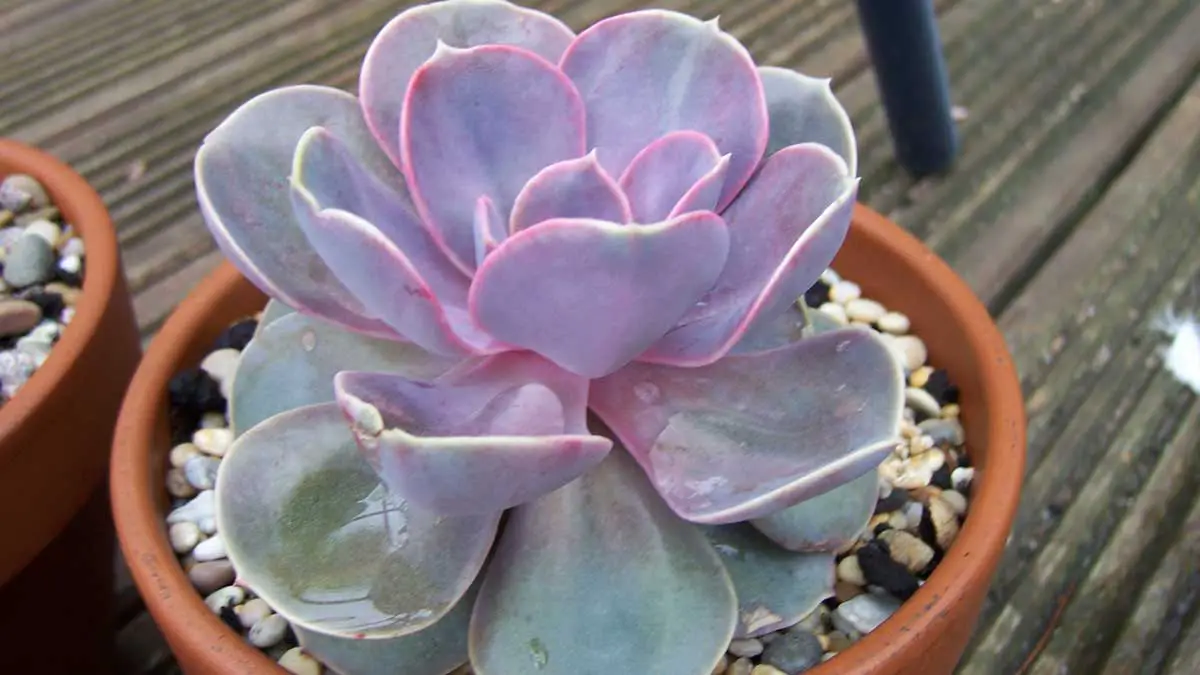
Echeveria ‘Perle von Nurnberg’ is not cold hardy; therefore, it can’t live outside when the temperature dips below 40°F (5°C).
If your winters are mild, you can grow these plants outdoors throughout the year, but people living in freeze zones have to overwinter them by bringing them indoors before the frost because the freeze will kill these plants.
Echeveria ‘Perle von Nurnberg’ does need a lot of light during the winter, so if you have to keep them inside, place them in a south-facing window where they can get at least 6 hours of full sunlight a day.
Echeveria ‘Perle von Nurnberg’ does not need a lot of water during the wintertime, but it’s a good idea to give these plants a little water every once in a while, only if the soil has dried out. Water more frequently during summertime.
How To Propagate Echeveria ‘Perle von Nurnberg’
Echeveria ‘Perle von Nurnberg’ can be grown easily from leaf cuttings or offsets.
Leaf Cuttings
Using a sharp blade to propagate by leaf cuttings, remove a leaf from the plant.
Place it in an area that receives bright indirect light and allow it to callous for a few days before planting in a new pot. It is best if the cuttings are 3-4 inches long and are only taken from healthy leaves.
Place the leaf cutting in well-draining soil (preferably cactus mix). Water sparingly until new growth appears.
New roots will form in time, and the leaf cutting will root in its new pot to grow into a small plant all on its own.
Offsets
Offsets are small rosettes that form on the mother plant and can be easily pulled off or cut away with a sharp blade.
Replant the offset in a new pot and allow it to sit for a few days before watering.
Keep the offset out of direct sunlight until new growth begins, then place it in an area that receives bright indirect light.
Is the Echeveria ‘Perle von Nurnberg’ Toxic?
Echeveria ‘Perle von Nurnberg’ is non-toxic and is considered to be safe for humans and pets. However, it is not recommended to eat it.
Always remember to wash your hands after handling a succulent plant to avoid spreading any plant disease or fungal infection.
Final Thoughts
Growing succulents can be a lot of fun, even for beginner gardeners. There are many succulents, each with its requirements and care process.
Growing Echeveria ‘Perle von Nurnberg’ succulents is easy and so much fun.
This succulent is ideal for both indoor and outdoor use. It is easy to propagate and grow in a typical home or garden environment.
Growing Echeveria ‘Perle von Nurnberg’ in your garden can add color and diversity. They also make an excellent houseplant and can be used in many types of containers.
Echeveria ‘Perle von Nurnberg’ care is easy. It requires very little attention to grow healthy and beautiful succulent plants.
Now that you know how Echeveria ‘Perle von Nurnberg’ works, it’s time to get started planting!

